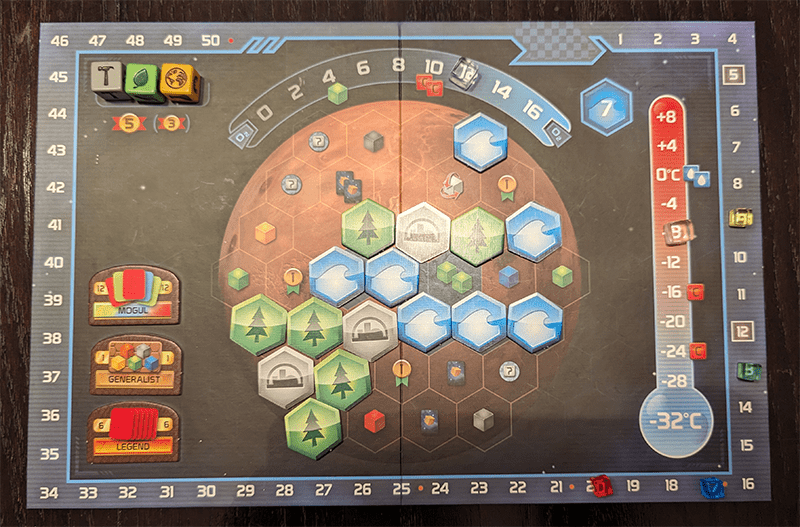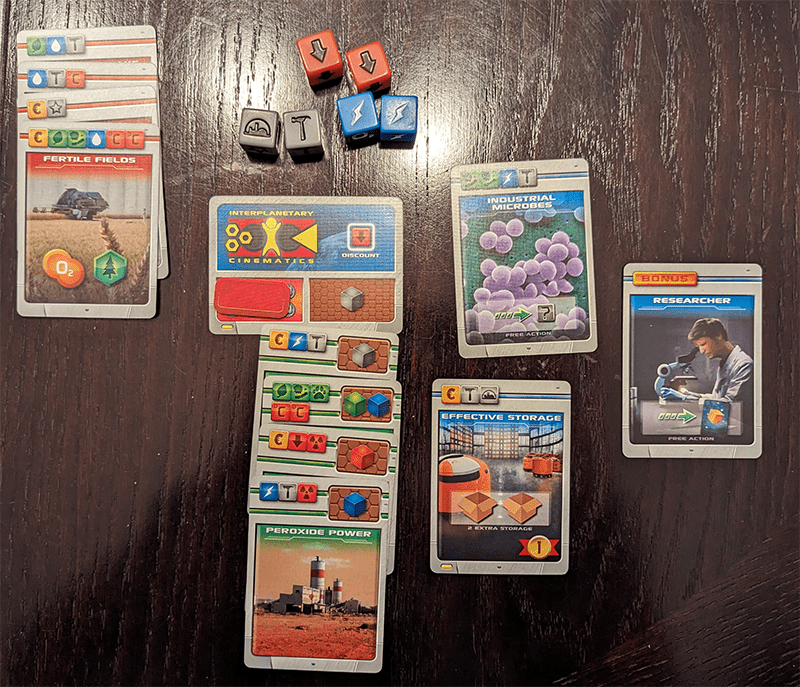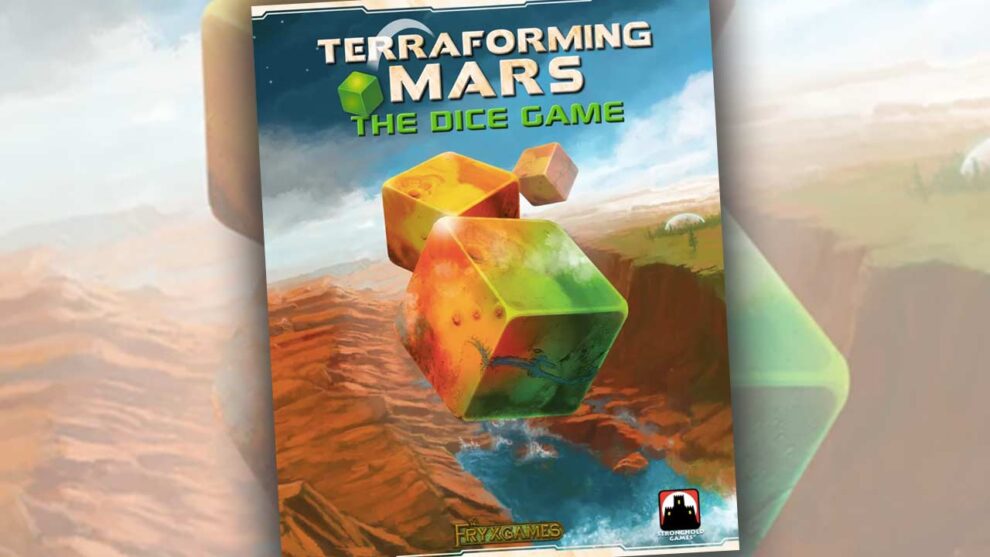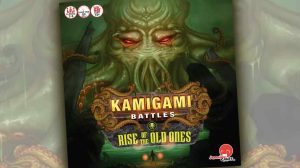Disclosure: Meeple Mountain received a free copy of this product in exchange for an honest, unbiased review. This review is not intended to be an endorsement.
I’m going to make a new law.
It’s a simple one. The more complex and longer the game is, the higher the chance there will be a dice version of it in the future.
We’ve already seen popular, complex board games simplified into quicker, more random dice games, perhaps to appeal to a wider audience. The epic scifi 4X game Twilight Imperium was condensed into a simpler dice-based version more reminiscent of an April Fools’ joke without a punchline. Nations, an already lengthy civilization game, underwent a similar transformation. Now here we are with Terraforming Mars, an intricate 3+ hour strategic card game and engine builder that has now been distilled down into a stripped down dice game.
And like the previous versions of Terraforming Mars, the story is still the same. Players take on the role of CEOs tasked with terraforming Mars by raising its oxygen levels, temperature, and ocean coverage along three tracks. Where this dice version differs is that only two of these parameters need to be maxed out to trigger the end of the game, streamlining playtime to the advertised 45 minutes – a rarity among board games. So while veteran fans will recognize the essential experience of racing to make Mars habitable, it has been pared down to its most basic bones, shedding complexity in favor of accessibility.

Lady Luck Lands on Mars
The familiarities don’t end there. You still have your hexagonal map of Mars, where you will mutilate the empty planet with forest, oceans, and city tiles for points as well as bonuses. Milestone objectives are something you can still race against your rivals to claim. The iconic card system also makes its appearance, with green cards providing production boosts, blue cards granting actions, and red cards offering immediate tactical effects
Not everything is the same, though, as you now have bonus cards you get for hitting a certain victory point criteria. Randomly chosen symbols designated for each game also allow players to score end game points for the majority of symbols on their project cards. Finally, all of your resources are now dice. There is no longer that famous player mat that keeps track of production and supply. Every single time you get a new die, you immediately roll it and deal with the symbol result.
To keep this theme of simplicity going, you are either doing an Action or a Production turn. Action turns begin with a Support action – either gaining a die of your choice, or discarding a die to draw more cards or rotate another die to any symbol of your choosing.
This is followed by one Main action: playing a card from hand by paying its symbol cost, taking another Support action, or trading specific resources to terraform Mars (raising temperature, adding oceans/forests/cities), or claiming victory points. This is where blue cards can be useful, as they provide additional Support or Main actions you can use, or if you’re lucky, a free action that you can take anytime on your turn, including a Production turn.
Production turns are basically a reset button. First, you will examine your current dice pool, keep three of them, and toss the rest. New dice are then added based on green production cards and promptly rolled. With dice results refreshed, you pivot your attention to your hand of project cards, culling useless cards, and then refilling your hand. Blue cards also reopen for reuse.
From Card Combos to Dice Manipulation
Now, after playing more than a handful of times, I have to confess that I’m a little confused about who this is for. While it retains the name and imagery of the original Terraforming Mars, it certainly doesn’t play the part. On the other hand, its presentation doesn’t exactly appeal to a casual audience.
The two words Terraforming Mars evoke expectations of complication, strategic depth, and engine building through cardplay. In Terraforming Mars: The Dice Game, these expectations are unmet. Gone are the prerequisite tags and synergies between project cards that formerly rewarded long-term planning. No more scrutinizing hands to create combos. Even the role of symbols is reduced – now simply serve as costs detached from any engine ties.
For the casual audience, the visuals leave a lot to be desired. The gray look on the cards and the artwork are a huge step back from Ares Expedition. Icons supplant the text, making it harder to understand the function of the cards for newer players. This wouldn’t be an issue if the player aids did explain the icons, but it doesn’t, and there are only two player aids for a four player game. It feels bizarre to bring this up considering Ares Expedition tried its damndest to onboard new players while this feels like a limp-wristed effort.
This might appear like a segue to talk about how I hate Terraforming Mars The Dice Game, but that isn’t the case. Despite its streamlined approach and sacrifice of strategic depth, I genuinely enjoy this game and believe it has redeeming merit. It’s certainly not the best game I’ve played this year, as that throne has a long line behind it, but the perceived flaws I’ve read online don’t hold up. If anything, I find the complaints about this game being “too random” to be an over exaggeration.

Symbol Showdown
Make no mistake, luck permeates this dice-driven rendition. Yet sound design provides avenues to mitigate the luck. “Wild” tokens substitute for symbols when rolls misalign. Green production cards boost dice pools, allowing more chances to hit at key results or spend them for Support actions. Blue cards lend powerful manipulation effects. Red card one-shots and tile placements on Mars frequently generate bonus dice. With careful optimization, you can leverage these tools to stack probabilities in their favor – concentrating rolls, tweaking outputs, and benefiting from volume. Lady luck’s hand is heavy here, but through canny use of the game’s mitigators, strategic play can make a brief appearance.
Rather than building long-term engines, Terraforming Mars: The Dice Game demands tactical efficiency by leveraging limited actions and random resources. With project cards and dice results fluctuating each turn, the focus becomes plotting the optimal route to finish terraforming goals before opponents. Bonus cards through victory point benchmarks add pressure to the race ahead, offering free project cards that can help with your short term goals. Outpacing others replaces engine-building as the main objective. By stripping away the long term engine building of the original in favor of an agile sprint fueled by variable dice and cards, it transforms the game into more of a “Race to Mars” than terraforming it.
However, I can’t ignore the consequences of trimming down the complexity. After playing this several times, it’s quite clear the game is repetitive since the game’s arc always remains the same. The first half of the game commands you to go for the milestones and earn points to grab those bonus project cards. You see that science milestone that wants you to have three blue project cards? Just play any three; don’t even think too hard about what they do. You want those four points.
Veterans May Crave More Strategic Substance
Once the bonus cards are claimed and the milestones disappear from the board, the second half of the game begins. Now the goal becomes utilizing played project cards to boost oxygen, temperature, and ocean levels while also blanketing Mars with forests and cities for points – all while tracking majority symbols for endgame bonuses. Players continue alternating action turns for dice and cards with production turns until the finish line – maxing out two out of the three parameters.
The root of this simplified strategic landscape lies in the project cards themselves. Unlike previous Terraforming Mars entries, where cards would compel reassessment of entire engine pathways, cards here simply convert dice to actions or resources rather than enabling a broader strategy. While one could defend such changes as necessary for a 45 minute duration, counterexamples abound of games offering deeper strategic avenues within an hour – classics like San Juan, Race for the Galaxy, or Res Arcana.
As a whole, Terraforming Mars: The Dice Game achieves its aims, even if it falls short of its acclaimed namesake. It successfully condenses the franchise into an accessible, brisk dice-driven affair, capturing the joy of racing to make Mars habitable even if the intricate engine-building surrenders to randomness. Does it retain the strategic depth many love? Absolutely not. More “gateway” than strategic replacement, Terraforming Mars: The Dice Game carves out a spot as a lighter complementary experience. And on its own lightweight terms, it succeeds admirably.












First, your law is spot on. I love it.
Second, I enjoy TM, but it is not a game a crave. Some of the people in my game group like it a hell of a lot more than me, so I have played it. But the ones that love TM are not going to like this diluted version, and those of us that enjoy TM to a lesser degree are not looking for this sort of an adaptation… so I am with you on the “who is this for?” question.
Very good review. Thanks!